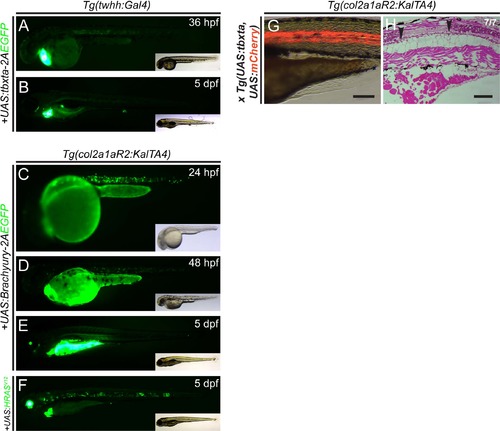Fig. S2
- ID
- ZDB-FIG-190821-18
- Publication
- D'Agati et al., 2019 - Active receptor tyrosine kinases, but not Brachyury, are sufficient to trigger chordoma in zebrafish
- Other Figures
- All Figure Page
- Back to All Figure Page
|
Tagged fusion proteins of Brachyury fail to express efficiently in vivo. (A-F) Lateral views of zebrafish embryos at indicated developmental stages, with EGFP fluorescence (green) in main panels, insets show brightfield for overall embryo morphology. (A,B) Transgene silencing in Tg(twhh:Gal4) with injected UAS:tbxta-2A-EGFP; while selectively expressed in the notochord at 36 hpf (n= 43/56), expression greatly reduced at 5 dpf. (C-F) Representative embryos transiently expressing UAS: Brachyury-2A-EGFP at 24 hpf at detectable levels (C), while expression becomes significantly reduced at 48 hpf (D) and is completely silenced at 5 dpf (E). (F) Transiently expressed UAS:EGFPHRASV12 at 5 dpf mainly localizes in the notochord and to a minor extent in the otic vesicle. Tumorigenic lesions could only be detected in the notochord. Transgenic markers used are myl7:EGFP for twhh:Gal4 and col2a1aR2:KalTA4, cryaa:Venus for injected UAS-plasmids. (G,H) Akin to injected UAS:tbxta, stable transgenic Tg(UAS:tbxta) overexpression fails to cause any significant notochord defect, with only few areas showing smaller vacuolated cells (arrowheads, H). |

